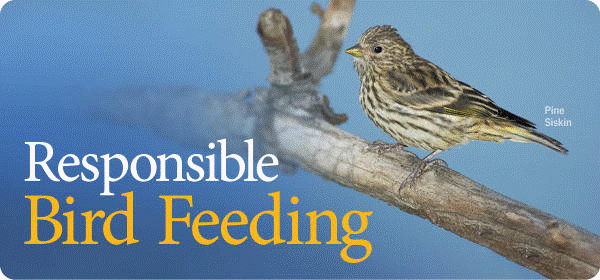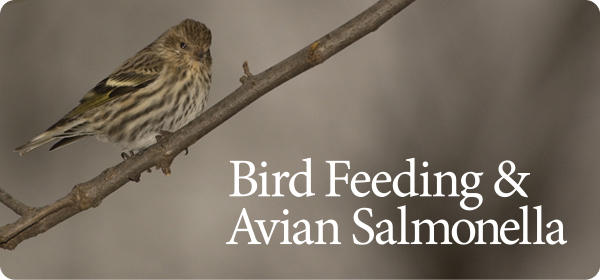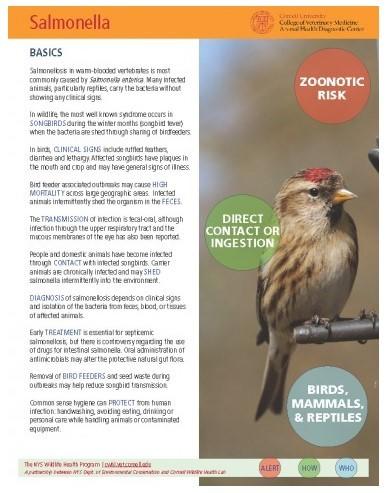Avian Salmonella: To Feed or Not to Feed?
The Facts
Salmonellosis (sal-muh-nel-LOW-sis) is a general term for any disease in animals and people caused by a large group of bacteria known as salmonella. Please note that while Wild Birds Unlimited has extensive experience and expertise in the care and feeding of wild birds; we are not experts on salmonellosis. The following information is provided as a guide.
What is Avian Salmonella?
Avian Salmonella is caused by a bacteria and is an uncommon cause of mortality in feeder birds. Occasionally, outbreaks of the disease cause significant mortality in certain species including Pine Siskin, Common Redpoll, and American Goldfinch.
What is Salmonellosis?
https://feederwatch.org/learn/sick-birds-and-bird-diseases/
Salmonellosis is caused by a bacteria belonging to the genus Salmonella. It is a common cause of mortality in feeder birds, but the symptoms are not always obvious. Sick birds may appear thin or fat and fluffed up and may have swollen eyelids. They are often lethargic and easy to approach. Some infected birds may show no outward symptoms but are carriers of the disease and can spread the infection to other birds. Salmonellosis is primarily transmitted by fecal contamination of food and water by sick birds, though it also can be transmitted by bird-to-bird contact. Occasionally, outbreaks of the disease cause significant mortality in certain species including Pine Siskin, Common Redpoll, and American Goldfinch. However, Salmonellosis does not contribute to substantial population decline in wild bird species. (https://www.michigan.gov/dnr/0,4570,7-350-79136_79608_85016-27268--,00.html)
Do bird feeders spread disease?
http://www.birds.cornell.edu/pfw/AboutBirdsandFeeding/FAQsBirdFeeding.htm#SpreadDisease
This question has at times been debated in the media. Feeders, especially improperly maintained feeders, can spread disease. However, there's no way to know if disease transmission at feeders is any less or greater than disease transmission in the wild. Birds that contract and spread diseases, such as salmonellosis, at feeders are typically social by nature and would aggregate whether at feeders or not. Nevertheless, to reduce the risk of disease at feeders, we encourage people to clean feeders regularly.
How is Avian Salmonella spread?
Salmonellosis is primarily transmitted by fecal contamination of food and water by sick birds, though it also can be transmitted by bird-to-bird contact during daily interactions and while roosting.
What should I look for at my feeders?
Sick birds may appear thin or fluffed up and may have swollen eyelids. They are often lethargic and are easy to approach.
What do I do if I see a sick bird?
https://feederwatch.org/learn/sick-birds-and-bird-diseases/
Because feeders offer you an up-close view of birds, and because birds seek out easy meals when their health is compromised, you might occasionally see a sick bird at your feeder. Only veterinarians or federally licensed wildlife rehabilitators can legally treat wild birds. If you see a bird that appears to be compromised in some way, perhaps due to sickness or injury, do not try to care for the bird yourself. It is illegal for you to possess most wild birds unless you are under the direction of someone licensed for their care.
If a sick bird comes to your feeder, minimize the risk of infecting other birds by cleaning your feeder area thoroughly. If you see several sick birds, take down all your feeders for at least a week to give the birds a chance to disperse. Remember that prevention is the key to avoiding the spread of disease. Regularly clean your feeders even when there are no signs of disease.
For more information on diseases affecting wild birds, contact the National Wildlife Health Center in the U.S. or the Canadian Cooperative Wildlife Health Centre in Canada. If you find a bird that you believe needs intervention to survive, contact a wildlife rehabilitator. The Humane Society website provides contact information for rehabilitators in the U.S. or in Canada websites by state or province.
Public health significance https://dnr.wisconsin.gov/topic/WildlifeHabitat/disease.html
The bacteria causing Salmonellosis in wild birds do have the ability to infect humans. Humans can minimize the risk of infection by wearing disposable gloves and taking extra care in personal hygiene when handling materials soiled by bird feces, including feeders, bird baths and bird houses.
What should I do to keep my birds safe?
See the section on Responsible Bird Feeding, below.
What about my Hummingbird feeder?
Hummingbird feeders do not need to be removed. It would be very unusual for a Hummingbird feeder to become contaminated with fecal material from an infected song bird.

Wild Birds Unlimited Recommends Responsible Bird Feeding
If you enjoy feeding and watching your backyard birds, then you probably want to do as much as you can to practice your hobby safely and ensure the birds’ overall health and well-being. While the incidence of birds falling ill from feeders is small compared to other natural hazards birds face, there are things you can do to help your birds stay healthy.
- Provide multiple feeding stations in different areas of your yard to disperse bird activity.
- Provide seed from a bird feeder rather than scattering it on the ground.
- Keep areas clean under and around your feeders.
- Keep fresh seed in the feeder and be sure it doesn’t get moldy.
- Clean your bird feeders regularly with a solution of one part bleach and nine parts water.
The following strategies will help improve the health and safety of birds when the spread of avian diseases is a concern.
- If feeder birds are exhibiting disease symptoms, then remove all feeders so local birds can disperse and utilize natural food sources.
- Clean and sanitize all bird feeders, bird baths and hardware with a 10% bleach (one part bleach to nine parts water) solution. Rinse thoroughly and allow to completely dry before refilling feeders. Continue to sanitize feeders every few days.
- Rake up and discard seed debris and bird droppings from the ground below and around feeders. Continue to clean these areas on a regular basis.
- Give the birds more space. If using multiple feeders, place the feeders farther apart from one another. This will reduce crowding, lower stress and lessen the potential for disease transmission between sick and healthy birds
- Only use feeders that can be easily cleaned. Replace wooden feeders with ones made of plastic or recycled materials for easier cleaning. Bird feeders with cracks and crevices are difficult to sanitize and should not be used.
- Temporarily remove open tray and platform feeders that allow fecal material and food to come into contact with each other.
- Initially reintroduce foods and feeders that will not attract finches (suet, safflower, peanuts, hummingbird feeders, etc. Reinstall finch feeders and food after an additional two weeks.
- Limit the amount of seed you provide. Offer only as much food as the birds will eat in one or two days.
- Always store bird food in containers that will not allow rodents to get into the food.
- Always discard any seed that has become wet, moldy or foul smelling.
- Avoid handling sick birds and always wash your hands with soap and water after filling bird feeders.
For other tips or questions, stop by our store and talk to one of our Certified Bird Feeding Specialists.
Link to Additional Printable Information from Cornell Lab of Ornithology



